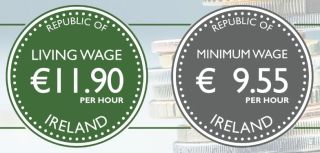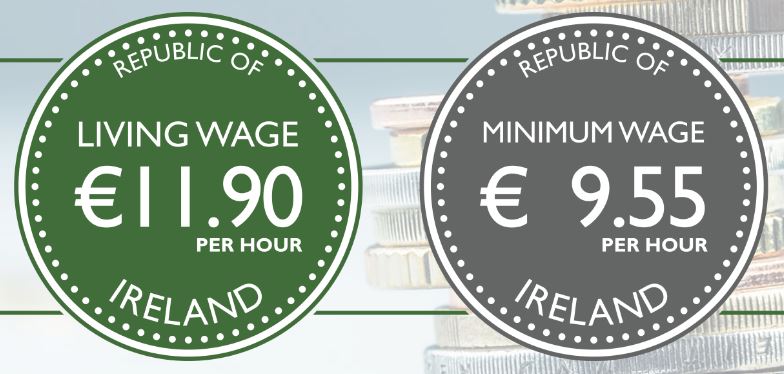A pathway towards a 'living wage' as a Minimum Wage is required


The Low Pay Commission's consultation process on the level of the National Minimum Wage (NMW) concluded last week. In our submission to the Commission, Social Justice Ireland argued that the NMW should, over the next few years, be moved closer to the level of the Living Wage.
Over the past five years Social Justice Ireland and a number of other organisations have come together to form a technical group which researched and developed a Living Wage for Ireland. The latest update was published in July 2018. It put the figure for a Living Wage at €11.90 per hour.
The confirmation in Budget 2019 of the previously announced increase of 25 cent per hour to the statutory (NMW) was a welcome development. This increase ensures that a full-time worker on the minimum wage will receive an additional €507 per annum in gross pay. However, the new hourly minimum wage rate of €9.80 is still approximately 18 per cent below the Living Wage of €11.90 per hour.
Addressing low pay remains a key challenge for Irish society. As we have continuously highlighted, annual poverty figures show that more than 100,000 people in employment are living in poverty (the working poor). Improvements in the low pay rates received by many employees offer an important method by which these levels of poverty and exclusion can be reduced.
What is a Living Wage?
In principle, a Living Wage is intended to establish an hourly wage rate that should provide employees with sufficient income to achieve an agreed acceptable minimum standard of living. In that sense it is an income floor, representing a figure which allows employees to afford the essentials of life.
Paying low-paid employees a Living Wage offers the prospect of significantly improving the living standards of these employees. Social Justice Ireland has supported the emergence of this concept over the past few years and we hope to see this new benchmark adopted across many sectors of society in the years to come.
The call for the introduction of a Living Wage for Ireland reflects a belief that individuals working full-time should be able to earn enough income to enjoy a decent standard of living. The Living Wage is a wage which makes possible a minimum acceptable standard of living. Its calculation is evidence-based and built on budget standards research which is grounded in social consensus. The current figure of €11.90 is:
- based on the concept that work should provide an adequate income to enable individuals to afford a socially acceptable standard of living;
- based on the average gross salary which will enable full time employed adults (without dependents) across Ireland to afford a socially acceptable standard of living;
- based on the desire provides for needs not wants;
- an evidence-based rate of pay which is grounded in social consensus and is derived from Consensual Budget Standards research which establishes the cost of a Minimum Essential Standard of Living (MESL) in Ireland.
The Living Wage is unlike the NMW in that it is based on the cost of living, while the NMW has never been set based on the cost of living.
In principle, the Living Wage is intended to establish an hourly wage rate that should provide employees with sufficient income to achieve an agreed acceptable minimum standard of living. Earnings below the Living Wage suggest employees are forced to do without certain essentials so they can make ends meet.
How is the Living Wage Calculated?
The Living Wage for Ireland is calculated on the basis of the MESL research in Ireland, conducted by the Vincentian Partnership for Social Justice. This research establishes a consensus on what members of the public believe is a minimum standard that no individual or household should live below.
Working with focus groups, the minimum goods and services that everyone needs for a MESL are identified. With a focus on needs not wants, the concern is with more than survival as a MESL is a standard of living which meets physical, psychological and social needs, at a minimum but acceptable level. Where necessary the core MESL data has been complemented by other expenditure costs for housing, insurance and transport.
The Living Wage Technical Group decided to focus the calculation of a Living Wage for the Republic of Ireland on a single-adult household. In its examination of the methodological options for calculating a robust annual measure, the group concluded that a focus on a single-adult household was the most practical approach. However, in recognition of the fact that households with children experience additional costs which are relevant to any consideration of such households standards of living, the group has also published estimates of a Family Living Income each year.
The calculations established a Living Wage for the country as a whole, with cost examined in four regions: Dublin, other Cities, Towns with a population above 5,000, and the rest of Ireland. The expenditure required varied across these regions and reflecting this so too did the annual gross income required to meet this expenditure. To produce a single national rate, the results of the gross income calculation for the four regions were averaged; with each regional rate being weighted in proportion to the population in the labour force in that region. The weighted annual gross income is then divided by the number of weeks in the year (52.14) and the number of working hours in the week (39) to give an hourly wage. Where necessary, this figure is rounded up or down to the nearest five cents. The number is updated on an annual basis.
The Merits of a Living Wage
Social Justice Ireland believes that concepts such as the Living Wage have an important role to play in addressing the persistent income inequality and poverty levels outlined earlier in this submission. There are many adults living in poverty despite having a job – the working poor. Improvements in the low pay rates received by many employees offers an important method by which levels of poverty and exclusion can be reduced. Paying low paid employees a Living Wage offers the prospect of significantly improving the living standards of these employees and we hope to see this new benchmark adopted across many sectors of society in the years to come.
Social Justice Ireland would like to see government commit to a timeframe over which the National Minimum Wage would move towards the rate of the Living Wage.
You can read Social Justice Ireland's full submission to the Low Pay Commission here.